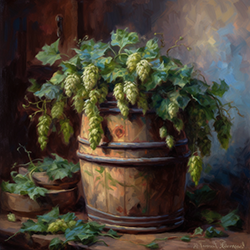Dancing with Alpha and Beta Acids: The Temperature Tango in Beer Brewing
Posted by Matteo Lahm on 17th Jan 2024
The art of brewing beer is a delicate dance, with each step in the process contributing to the final symphony of flavors and aromas that delight the senses. One of the lead dancers in this performance is temperature, which influences the extraction, isomerization, and solubility of alpha and beta acids found in hops. These acids are the maestros of bitterness and aroma in your beer. This article will guide you through the intricate choreography of temperature's impact on alpha and beta acids during the brewing process, helping you create a masterpiece in every glass.
Hops (Humulus lupulus) are the prima ballerinas of beer production, gracefully bestowing bitterness, flavor, and aroma upon your brew. The stars of the show are alpha acids (humulones) and beta acids (lupulones), which pirouette through the brewing process, influenced by factors such as temperature, pH, and wort composition. To create a beer that hits all the right notes, it's essential to understand the pas de deux between temperature and these acids.

1. Boiling and Isomerization of Alpha Acids
The boiling stage is where hops take center stage, and temperature plays a significant role in the isomerization of alpha acids. Isomerization is the transformation of alpha acids into iso-alpha acids, the virtuosos of bitterness in beer. The boiling temperature for wort is typically around 100°C (212°F), and the isomerization rate of alpha acids crescendos with temperature. A longer boiling time also results in higher isomerization rates, leading to increased bitterness. However, excessive boiling can cause the degradation of iso-alpha acids, dampening the overall bitterness.
2. Temperature Effects on Beta Acids and Aroma Compounds
While beta acids may not be the soloists of beer bitterness, they play a crucial role in the aroma ensemble. During the boiling process, beta acids undergo oxidation and form various volatile compounds that contribute to the beer's aromatic symphony. The rate of oxidation is temperature-dependent, with higher temperatures conducting increased oxidation rates. However, excessive heat can cause the evaporation of these volatile aroma compounds, muting the overall performance.
3. Dry Hopping and the Impact of Temperature
Dry hopping is the encore of the brewing process, where hops are added during or after fermentation to enhance aroma and flavor. The temperature during dry hopping can impact the extraction of both alpha and beta acids, as well as other aroma compounds. Lower temperatures (10-20°C or 50-68°F) are generally preferred for dry hopping, as they promote the extraction of delicate aroma compounds without encouraging excessive isomerization of alpha acids, which could lead to an off-key bitterness.
Conclusion
Temperature is the conductor of the brewing orchestra, guiding the behavior of alpha and beta acids throughout the process. By understanding the impact of temperature on these compounds, you can choreograph the bitterness and aroma profiles of your beers to create a diverse repertoire of styles and flavors. Mastering temperature control during boiling and dry hopping stages can result in a harmonious beer with the desired characteristics. As the curtain falls, further research into the complex interactions between temperature, alpha and beta acids, and other brewing factors will continue to enhance your understanding and ability to craft exceptional beers.

